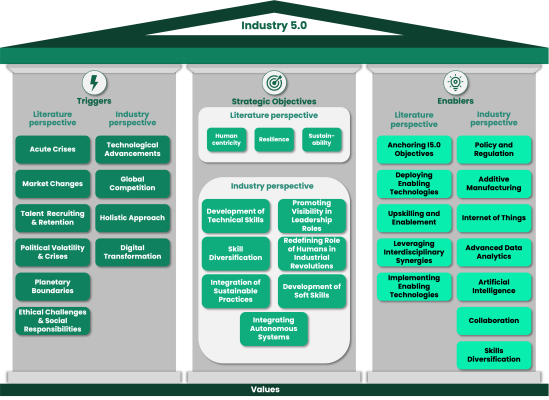From Challenges to Opportunities: Industry 5.0 Community Trends and Status
From Challenges to Opportunities: Industry 5.0 Community Trends and Status

Industry 5.0 Community Trends and Status Report published by the PROSPECTS 5.0 Project is a critical milestone laying the groundwork for addressing the challenges on the path to Industry 5.0 by synthesizing extensive research and expert input. This report not only consolidates existing knowledge but also identifies key gaps and trends, establishing a robust foundation for future project phases and the broader adoption of Industry 5.0 principles
Insights and Methodology
The report integrates findings from a systematic literature review (SLR) and a multi-round Delphi survey involving 14 experts from diverse EU countries. The SLR, analyzing 879 studies, identified recurring themes, methodological gaps, and the drivers and enablers essential for Industry 5.0 adoption. The Delphi survey complemented this by incorporating industryspecific insights, ensuring that the findings are not only academically robust but also practically relevant. Key findings reveal that Industry 5.0 must address interconnected triggers such as acute crises, market dynamics, talent shortages, political volatility, and planetary boundaries. These triggers underscore the urgency of creating adaptive, humancentered systems. Enablers, such as collaborative robotics, advanced analytics, circular economy models, and interdisciplinary synergies, emerged as pivotal tools for navigating this transformation.
Strategic Pillars of Industry 5.0
The PROSPECTS 5.0 framework emphasizes three core strategic pillars-sustainability, human-centricity, and resilience-each of which aligns with the European Commission’s vision for Industry 5.0:
- Sustainability focuses on circular processes that minimize waste and environmental impact, leveraging technologies such as AI and additive manufacturing to optimize resource use.
- Human-Centricity places workers at the core, using technology to enhance wellbeing, creativity, and safety. Collaborative robots, so called cobots, exemplify this, as they support rather than replace human labor, fostering fulfilling workplaces.
- Resilience emphasizes robust systems capable of adapting to disruptions, whether from global crises or supply chain volatility. Flexible production capacities and datadriven decision-making are critical components of this approach.
Bridging Theory and Practice
Industry 5.0 Community Trendsand Status Report highlights the importance of bridging academic frameworks with industry applications. It identifies gaps in existing methodologies, such as a lack of focus on interdisciplinary approaches and the underrepresentation of human-centric strategies in traditional Industry 4.0 models. By addressing these gaps, the report provides actionable insights that industries can use to embed Industry 5.0 principles into their operations.
For instance, in sectors like life sciences, sustainability and regulatory compliance are paramount, requiring innovative solutions that meet stringent standards while aligning with environmental goals. Meanwhile, heavy industries benefit from adaptive manufacturing powered by AI-driven analytics and predictive maintenance. Across all sectors, the adoption of circular economy models and advanced technologies enhances efficiency and supports long-term environmental objectives.
The Role of the Delphi Study
The Delphi survey enriched these findings by capturing perspectives from diverse industries. Experts identified critical enablers such as upskilling and enabling the workforce, embedding Industry 5.0 goals into corporate strategies, and leveraging interdisciplinary synergies. They also stressed the need for robust policies and ethical frameworks to ensure that technological advancements align with societal values and protect data security.
One notable insight is the emphasis on human-machine collaboration. Rather than viewing technology as a replacement, Industry 5.0 envisions it as a complement to human capabilities. Cobots, for example, enhance productivity by taking on repetitive tasks, allowing workers to focus on innovation and problem-solving. Such technologies not only improve efficiency but also address societal concerns about job displacement, fostering trust and acceptance among employees and consumers alike.
Looking Ahead to the PROSPECTS 5.0 Vision
With the release of Industry 5.0 Community Trends and Status Report, PROSPECTS 5.0 has established a solid foundation for advancing its project goals. By prioritizing humancentricity, sustainability, and resilience, Industry 5.0 not only aligns technological innovation with societal and environmental priorities but also strengthens Europe’s global competitiveness. This milestone provides actionable insights to shape policy frameworks, enhance skills, and foster broad acceptance of Industry 5.0 principles.
Author: Clara Herkenrath (FIR at RWTH Aachen University)
